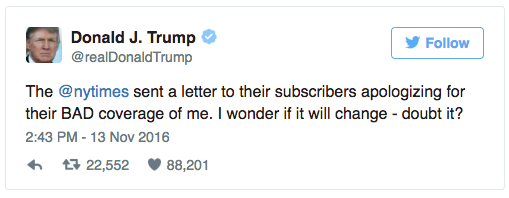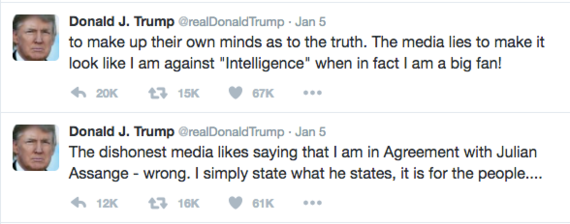The media has been criticised for its reporting of the US presidential election campaign and the EU referendum. Several media outlets were accused of biased coverage and excessive focus on personalities rather than policies. Journalists working on these two campaigns have had to determine how to report on politicians' false claims.
These two political campaigns have led to a heightened focus on "post-truth" in the media. On BBC Radio 4's The New World, Professor Stephan Lewandowsky from the University of Bristol said the term "post-truth" has "come out of nowhere and exploded into the media scene." He argues that people have become more entrenched in false beliefs. "They're inclined to put feelings first and make facts fit."
One of the most serious problems of the post-truth age is the spread of fake news. Journalists are pressured to come up with new content at a fast pace. This can lead to 'churnalism' where false stories slip under the radar. For example, the story about the Corona founder making everyone in his hometown a millionaire. The false story was reported by the Independent, the BBC, and the Press Association.
There are many other challenges that come with political reporting in a post-truth world. If media outlets do not cover candidates equally, there can be grave consequences. Providing accurate, fact-checked news is essential to quality reporting. However, it has been proven that bombarding audiences with facts and statistics is ineffective. Communicating how these figures affect real people provides a more successful alternative.
Collaborative journalism can help reporters overcome the challenges of the post-truth age. This could be through online platforms like Twitter, or by integrating with communities. Working collaboratively allows journalists to share stories with the public so they can be transparent about their evidence. To ensure these stories reflect the wider community, reporters must speak to a diverse range of people from different socio-economic backgrounds, races, ethnicities, religions, genders, and sexualities.
Journalism should be focused on the people behind stories, and the communities affected by government policies. Journalists should go into communities to see how political decisions affect the people living there, instead of simply talking to politicians and officials. In the South Wales Valleys, people predominantly voted to leave the EU. Following the election result, there were many reports on why they voted Leave when they received millions of pounds worth of investment from the EU.
In an interview with the Guardian, Remainer Deborah Basini, from Ebbw Vale, said that there are hardly any immigrants in the area. "It's just ... illogical. I just don't think people looked at the facts at all." If journalists embedded themselves into places like Ebbw Vale, perhaps they would have been more in touch with communities and, as a result, people would not have been as shocked with the referendum result. The same could be said for the presidential election.
When reporting on politics, should journalists give equal weight to candidates when what they are saying is untrue?
Fact checking and accurate reporting is essential, but how we label statements as false is also important. The Executive Director of the American Press Institute, Tom Rosenstiel, argued "one of the many watersheds in the 2016 campaign came when The New York Times used the word "lie" in a front-page story about Donald Trump in September." Labeling Trump a liar further alienated his supporters.
NPR's Senior Vice President of News and Editorial Director, Michael Oreskes, explains in a column that if you want your reporting to reach as many people as possible, this kind of approach is counterintuitive. "It is a well-established piece of social science research that if you start out with an angry tone and say something a listener disagrees with, they will tune out the facts. But if you present the facts calmly and without a tone of editorializing, you substantially increase the chance that people will hear you out and weigh the facts."
Michael Goodwin, writing for The New York Post, accused The New York Times of demonizing Trump throughout the election campaign. Mr Goodwin argued "because the paper decided that Trump's supporters were a rabble of racist rednecks and homophobes, it didn't have a clue about what was happening in the lives of the Americans who elected the new president."
After the election result, The New York Times wrote a letter to its readers admitting it underestimated the level of support Trump had among voters.
Donald Trump tweeted his interpretation of the letter to his 19 million followers.

The New York Times did not explicitly admit wrongdoing in their letter, but Mr. Trump's tweet makes it appear as though they did. The paper released a statement following their reporting of the presidential election saying "we aim to rededicate ourselves to the fundamental mission of Times journalism." Despite this statement, Mr. Trump's supporters may still trust his tweet. This would be an example of confirmation bias, the psychological tendency for people to accept information that affirms their pre-existing beliefs.
Donald Trump frequently labels the media as "dishonest" in his tweets, which has contributed to a climate of blurred lines between reality and falsehood.



However, the media can, and does, use Twitter to its advantage. When researching a story on the whereabouts of a Trump portrait, David Fahrenthold of the Washington Post, reached out to his followers. He said "I had attracted a virtual army, ready to join the scavenger hunt." Through their help, Mr. Fahrenthold discovered a $10,000 portrait of Trump, bought illegally with charity money. Mr. Fahrenthold's use of Twitter resulted in a transparent investigation.
In a post-truth age, it has become more difficult to separate fact and fiction because of the spread of fake news, particularly on social media. To fight fake news, reporters must make a conscious effort to produce accurate and transparent content and present facts in a more emotionally engaging way. Journalists can counter the negative connotations of the post-truth age by producing collaborative, diverse, and people-focused stories.
